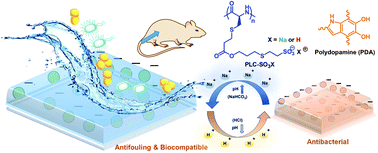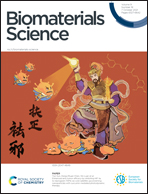A sulfonate-based polypeptide toward infection-resistant coatings†
Abstract
Multifunctional coatings have gained significant attention for their promising potential to address the issue of medical device-related infections. However, they usually have multiple components in one layer which decreases the density of functional groups on surfaces and hence reduces the biological properties. Herein, we report a mono-component and sulfonate-based anionic polypeptide coating with on-demand antibacterial activity, antifouling property, and biocompatibility. The anionic polypeptide was prepared by ring-opening polymerization of L-cysteine-based N-carboxyanhydride (NCA) with allyl groups and a subsequent thiol–ene reaction to incorporate the sulfonate pendants. It adopted a 17.1–19.5% β-sheet conformation and self-assembled into a spherical nanoparticle. The polypeptide coating showed excellent in vitro antibacterial activity against both Gram-positive (i.e., S. aureus) and Gram-negative bacteria (i.e., E. coli) with >99% killing efficacy after acidic solution treatment and prominent antifouling property and biocompatibility after weak base treatment. An in vivo study revealed that the sulfonate-based polypeptide-coated polydimethylsiloxane (PDMS) exhibited good anti-infection property and histocompatibility.



 Please wait while we load your content...
Please wait while we load your content...